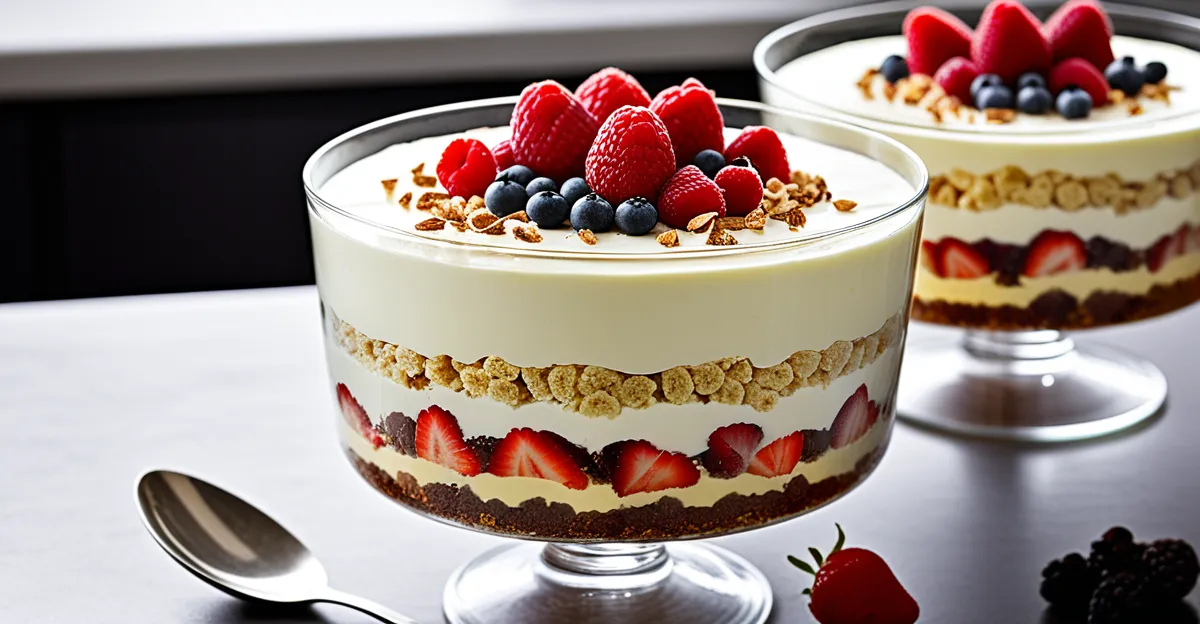Achieving Flavor Balance in a Classic Trifle
Creating flavor balance in trifle is essential to elevate the dessert beyond simple layering. Each component—sponge, fruit, custard, and cream—must complement rather than overpower one another. The sponge serves as the base, providing a subtle texture that absorbs the flavors without becoming soggy. The fruit adds brightness and a natural acidity that counteracts the sweetness of custard and cream.
Sweetness and acidity are the heart of achieving flavor harmony. Overly sweet custard can dull the dish, so incorporating fruits with a tart profile helps maintain balance. Conversely, too much acidity without a creamy layer risks overshadowing the dessert’s sweetness. Adjusting the proportions allows customization based on personal preference or seasonal ingredient availability.
Also to discover : How Does Traditional UK Cooking Influence Modern British Cuisine?
When considering dessert layering tips, start with sponge soaked lightly in liqueur or juice, add a vibrant fruit layer, then a generous custard portion followed by smooth cream topping. This sequence ensures balanced flavors unfold with every bite. Remember, the goal is not just to stack ingredients but to create a classical trifle experience where every spoonful delivers a well-rounded, delightful taste.
Selecting and Pairing Ingredients for Optimal Taste
Selecting the right ingredients is fundamental to creating a flavor balance in trifle. The base sponge, whether cake, ladyfingers, or genoise, impacts the trifle’s texture and how it absorbs moisture. A light, airy sponge such as genoise is perfect for soaking up liqueurs without becoming overly soggy, while ladyfingers add a firmer bite that contrasts well with softer layers.
In parallel : What are the best techniques for preparing a hearty toad in the hole?
Fruit selection also plays a crucial role in the trifle ingredient selection process. Balanced acidity from berries or citrus fruits brightens the dessert and cuts through the richness of custard and cream. Pairing fruits with complementary liqueurs—like brandy with cherries or Cointreau with oranges—can enhance freshness and add depth.
Choosing the right custard and cream types further boosts flavor harmony. A thick, vanilla custard adds sweetness and smoothness, contrasting with whipped cream’s airy texture and mild taste. This combination allows the flavor balance in trifle to shine through, preventing any one component from overwhelming the palate.
These trifle ingredient selection and flavor pairing steps are essential in a classic trifle guide, ensuring each layer contributes to a cohesive and enjoyable dessert experience.
Expert Tips to Perfect Your Trifle Layers
Mastering trifle layering tips ensures each bite delivers the true joy of a classic trifle. The ideal sequence starts with soaking the sponge lightly in a chosen liqueur or juice. Soaking just enough avoids sogginess while allowing the sponge to absorb flavor fully. Next, arrange a fresh fruit layer that provides acidity and brightness, perfectly balancing the richness to come. Then, spread a thick custard layer to add smoothness and sweetness before topping with light whipped cream to create an airy finish.
Professional chefs emphasize controlling moisture to maintain structure. One effective technique is chilling the sponge after soaking to help it firm up. Using thicker custards also helps prevent the layers from blending too much. When assembling, press down gently on each layer to eliminate air gaps but avoid compressing the sponge excessively.
For an enriched taste experience, alternate fruits and custard in thinner layers rather than one thick fruit or custard section. This technique promotes flavor balance in trifle throughout the dessert. Remember, the goal is not just stacking but layering in a way that allows each component—sponge, fruit, custard, and cream—to shine individually yet harmonize perfectly, elevating the classic trifle into a sophisticated treat.
Avoiding Common Mistakes in Trifle Preparation
Mistakes in trifle preparation often undermine the intended flavor balance in trifle and can result in disappointing texture and taste. A frequent error is over-soaking the sponge layer. While moisture is essential for flavor infusion, too much liquid causes sogginess, compromising the sponge’s structure and muddling layers. Conversely, under-soaking leaves the sponge dry and disconnected from surrounding flavors, disrupting the dessert’s harmony.
Another common pitfall lies in the imbalance of cream, custard, and fruit ratios. Excessive cream dulls the trifle’s brightness, while too much fruit acidity without enough custard can make the dessert overly tart. Achieving flavor balance in trifle requires careful proportion adjustments to maintain sweetness and acidity in harmony.
Consistency issues also arise when layers mix unintentionally. For instance, excessively runny custard or thin cream leads to blending layers, muddling distinct textures. Using thicker custard and properly whipped cream prevents this and preserves the separate layers emphasized in any classic trifle guide.
By recognizing and addressing these common trifle consistency problems, home cooks can follow effective dessert layering tips to ensure each component stands out while contributing to the overall sophisticated flavor experience.








